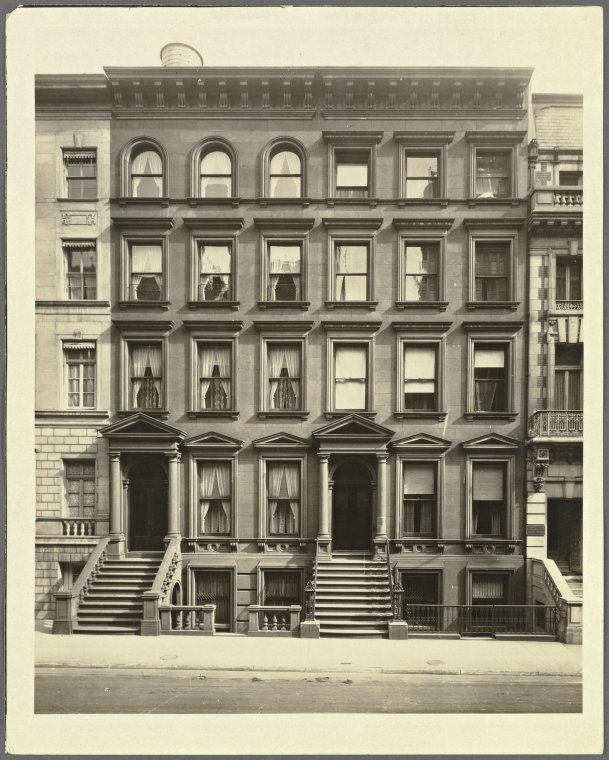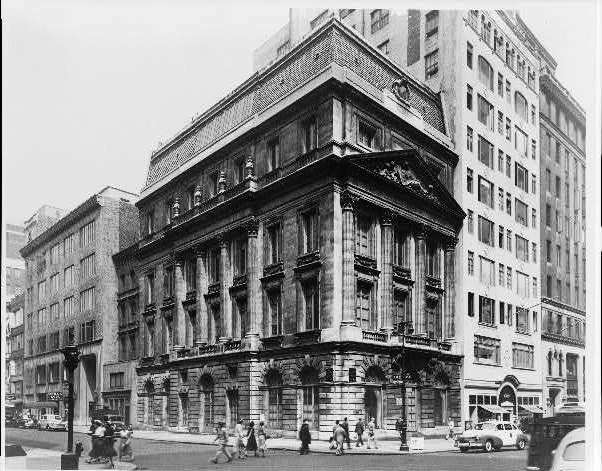Cats in the Mews: September 8, 1902
This story about the pet cat of Edwin Gould is a sad summer tale, but it provides a window into a world in which the wealthy treated their jewels and other inanimate objects far better than their pets.

On September 8, 1903, the New York Evening World reported that a gray and white cat had been living on the steps of the Edwin Gould house at 7 West Fifty-Sixth Street for more than a week. The reporter surmised that she may have been a family pet that was left behind when the Goulds left the city house and went to their new country estate on the Hudson River at the start of the summer.
Passersby said the emaciated cat looked like a former pet cat that had once seen better days. Others thought that perhaps the cat was one of the many forgotten pet cats who spent their summers scavenging from the garbage pails in the nearby Central Park when their wealthy owners left town.

Whichever theory was true, the poor kitty had been spending every day lounging on the stoop or standing on the window sill and peering inside the empty house. The only time she left the house was when a stray dog chased her away, or when a more fortunate pet dog walked by with its owner.
At night, she kept the neighborhood awake with her cries.
I don’t know what happened to this poor cat, but I have a feeling it did not have a fairy-tale ending. According to the ASCPA, cats were abandoned more than any other family pet when the well-to-do of the Gilded Age left their city homes to spend the summer abroad or at a country estate.
Although some wealthy families boarded their cats for the summer, and a few lucky cats, like Rusty of the Algonquin Hotel, traveled with their owners to their summer homes. many cats were left behind. Way too many abandoned cats were picked up by the ASPCA and sent to the gas chamber if no one came to claim them within a few days.
The Mystery of the Edwin Gould Story
As I was writing this story, I discovered a few discrepancies with the Evening World news article. The first thing I noticed was that the cat appears to be “Photoshopped” in the picture from the Evening World. It looks like the photographer took a picture of the stoop and then superimposed another photo of a cat on top of that, giving the cat an odd, 3D appearance.
I’m not even sure if the stoop belongs to 7 West 56th Street either. If you compare the architectural details of the photo above with the photo below, there are quite a few differences. (I don’t know when the photo below was taken, so the house could have undergone extensive renovations.)

The second problem is that Edwin Gould did not live at 7 West 56th Street. According to an article in the New York Herald, William H. Garden owned the home on 56th Street.
Edwin Gould lived in the mansion directly across the street from this house, at 720 Fifth Avenue. Big difference.
The five-story, 50-foot mansion on Fifth Avenue was constructed in 1879 for a millionaire named George Kemp, who made his fortune in perfumes and body-splashes. Kemp died in the home in 1893, and his wife passed away in 1897. Shortly after her death, the home was leased to Edwin Gould.

The Goulds lived in this home at least until 1908. Although they made extensive renovations to the mansion, it doesn’t appear to have any stoops on which a cat could sit. I have a feeling the reporter may have exaggerated the story to get a larger headline, but that’s my opinion only, based on the facts provided.
In 1911, the Duveen Brothers, dealers in fine art, leased the building at 720 Fifth Avenue for a term of 20 years. In October 1952, Emery Roth & Sons designed the $1.25 million, 15-story office building that still stands today. Directly across the street on Fifth Avenue is Trump Tower.
The Very Charitable Edwin Gould, Sr.
“Edwin was probably the happiest of the Goulds, and he might well have been the richest of them all, had he not persisted in giving away large sums of capital and much of his annual, income each year.”–The New York Times
Edwin Gould was born in Manhattan on February 26, 1866. The son of railroad magnate and financier Jay Gould and Helen Day Miller, Edwin was born into wealth and privilege. With a very large inheritance and three years of studies at Columbia University under his belt, he was worth $20 million by the time he turned 27 (including $8 million that he made on his own, without his family’s help).

In 1892, Edwin married Sarah Cantine Shrady. The couple had two children: Frank Miller Gould and Edwin Gould, Jr., who died during a hunting accident in 1917 at the age of 23 (he accidentally shot himself with his own gun).
In 1902, Edwin Gould purchased 88 acres of land in the Wickers Creek section of Dobbs Ferry on the Hudson River (the present site of Mercy College). There, he built a 40-room mansion of Spanish architecture.
The Goulds call their estate “Agawam.” It may have been here that the family spent the summer of 1903, leaving their alleged cat behind.
According to historians, it was during the funeral services for Edwin Jr. that Edwin Gould decided to devote the rest of his life to helping children. Apparently, the children of a local children’s home called Sheltering Arms sent a large basket of roses–one rose for each child–to the funeral home.
Edwin and Sarah were already friends and benefactors of the home (they often gave the children circus tickets and ice cream), but it was this special memorial to their son that inspired the couple to devote their fortune and time to kids in need. Over the years, thousands of young people benefited from the schools, parks, playgrounds, and other facilities that the Goulds helped finance.

In 1923, Edwin established the Edwin Gould Foundation for Children to ensure that his legacy and commitment to helping children would continue after his death. He died at his summer home in Oyster Bay, Long Island, on July 11, 1933, at the age of 67. He was buried in the family plot at Woodlawn Cemetery.



What a sad story…but one that should be told. I live in France, and while many people here love their pets and take good care of them, (too) many others abandon pets for the summer, just like this. And of course, your post also brings up such a fascinating mystery, perfect for an architecture and history fan like you to investigate! Thanks for another intriguing read.
I was adopted by a 6 month old kitten left behind when his family moved away. It is sad that this still happens, most often to cats. Dogs are at times left behind as well but usually rescued sooner. Love the historical overviews you prove with your history stories.